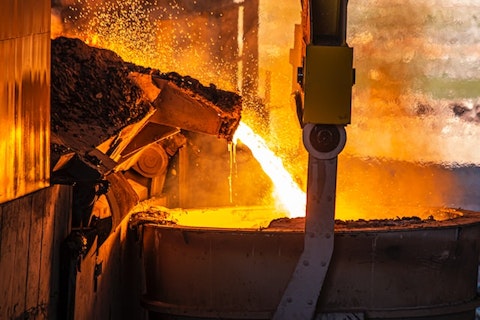TimkenSteel Corporation (NYSE:TMST) Q4 2022 Earnings Call Transcript February 24, 2023
Operator: Good morning. My name is Chris, and I will be your conference operator today. At this time, I would like to welcome everyone to the TimkenSteel Corporation Fourth Quarter and Full-Year 2022 Earnings Call. All lines have been placed on mute to prevent any background noise. After the speakers’ remarks, there will be a question-and-answer session. I will now hand it over to Jennifer Beeman, Director of Communications and Investor Relations. You may begin.
Jennifer Beeman: Thanks, and good morning, and welcome to TimkenSteel’s fourth quarter and full-year 2022 conference call. I’m Jennifer Beeman, Director of Communications and Investor Relations for TimkenSteel. Joining me today is Mike Williams, President and Chief Executive Officer; Kris Westbrooks, Executive Vice President and Chief Financial Officer; and Kevin Raketich, Executive Vice President and Chief Commercial Officer. You all should have received a copy of our press release which was issued last night. During today’s conference call, we may make forward-looking statements as defined by the SEC. Our actual results may differ materially from those projected or implied due to a variety of factors, which we describe in greater detail in yesterday’s release.
Please refer to our SEC filings, including our most recent Form 10-K and Form 10-Q and the list of factors included in our earnings release, all of which are available on the TimkenSteel Web site. Where non-GAAP financial information is referenced, additional details and reconciliations to its GAAP equivalent are also included in the earnings release. With that, I’d like to turn the call over to Mike. Mike?
Mike Williams: Thank you, Jennifer. And I appreciate everyone joining us this morning. 2022 was certainly a tale of two halves. Through the first six months of the year, we achieved record adjusted EBITDA and strong operating cash flow. Our success was attributed to our commercial strategies which focused on high-value end markets, including defense, renewable, and electric vehicles, as well as portfolio enhancements and an improved pricing environment. Fortunately, strong end markets prevailed throughout the year. But in the second-half of 2022 we experienced a number of operational issues which resulted in substantial unplanned downtime and significantly impacted our financial results. First, let me categorically state, our safety performance in 2022 was not acceptable.
And every single person at TimkenSteel is dedicated to change. We are fully committed to improving our safety performance. And in 2023, we expect to invest approximately $7 million in companywide training, equipment, and improved safety processes to ensure we are creating a lasting culture of safety. Ongoing improvements include enhanced response drills, job safety analysis, housekeeping, management system advancements, and additional hazard mapping processes. In recent weeks, we have kicked off the first phase of advanced safety training throughout the entire organization. And these efforts will continue for the duration of 2023. While safety is a continuous journey, our job, every day, is to provide the safest working environment as possible and equip our people with the best tools and training to safety perform their jobs.
Moving to operations, our production ramp up has been slow and methodical spanning several months. As I mentioned, we have focused on implementing additional safety processes, and in some cases with completely new teams, all while driving best-in-class quality to ensure we meet our customers’ demanding requirements. To support our operational continuous improvement, we have increased our budgeted capital expenditures for 2023 to approximately $45 million, and have several work streams focused on enhancing our manufacturing excellence and asset reliability programs. Turning to the results, fourth quarter net sales declined 23% sequentially as a result of a market-driven reduction in surcharge revenue per ton due to lower scrap and alloy prices, as well as the impact from lower shipments.
We are maintaining a constant and transparent dialogue with our customers. And while there is frustration that short-term demand is outpacing our supply, we are steadily working to fulfill orders. I am encouraged that in the first quarter of 2023, we are seeing consistent positive utilization trends. I believe this momentum will continue as teams are fully trained and begin to work more efficiently together. Moving to customer contracts, our annual customer price agreement negotiations, which cover approximately 70% of our order book, have been completed with an average base price increase in the mid-to-upper single digits on a percentage basis, compared with 2022 average base pricing. Given that market strength has continued into 2023, our order book is expected to remain full throughout the first-half of 2023.
On a positive note, demand remains robust in all of our end markets. Infrastructure spending, automation, reshoring, and supply chain de-risking are driving increased demand for our products in our targeted end market sectors. Our industrial shipments decreased by 33% sequentially given our continued melt shop restraints. However, defense and mining sectors remain strong. In defense, the expansion of the U.S. industrial supply base for major Department of Defense programs continues to drive demand for our products and services. In mobile, shipments decreased by 5% compared with the prior quarter. Similar to the third quarter, mobile customers were less impacted in the fourth quarter given our inventory on hand to support their specific needs.
Otherwise, light vehicle production continues to increase to support automotive demand and the continuing inventory replenishment. Our energy shipments declined 18% sequentially based on our shipping constraints. However, the market’s lower-than-normal inventory levels, increased demand, and sanctions against Russia continue to support U.S. drilling activity. Our customers continue to order at a high rate to support drilling and completion activity while maintaining balanced inventory levels. Currently, we are on track to achieve our targeted $80 million of profitability improvements by 2026. As a reminder, our actions focus on commercial excellence, manufacturing, and reliability excellence, and administrative process simplification with a strong balance sheet as our foundation.
We have launched several initiatives related to manufacturing productivity, reliability, and efficiency that are included in our 2023 capital expenditure budget. A few examples include adding a new fire grate to our melt shop which will aid in refining consistency and overall shop reliability, upgrading our electric arc furnace control system for energy efficiencies. Also, adding in process surface quality gauges in our rolling and tool-making operations to improve first-time quality, and also, automating final product testing in our metallurgical laboratory. We remain committed to investing in our assets and our people, as well as scalable AI technologies that enhance value and improve our safety, quality, reliability, and cost, and in some instances, aiding in our sustainability efforts.
Examples include technologies that allow us to quickly detect a changing condition or events that could impact safety, quality, production, or reliability within our manufacturing environment. We will also embrace technologies that give us early warning signs of the deterioration of machinery and components, allowing us to proactively act and ultimately driving lower cost. As you may recall, we have undertaken a process to move our scrap yard to be adjacent to our melt shop to improve efficiency and reduce emissions. We expect to become fully operational, in April, with a run rate savings of $2 million annually. We are grateful for the support of our customers, suppliers, and shareholders, and our dedicated employees who have embraced continuous improvement related to safety, manufacturing, commercial excellence, and process simplification, which we believe will lead to sustainable through-cycle profitability.
Now, I would like to turn the call over to Kris. Kris?

Photo by yasin hm on Unsplash
Kristopher Westbrooks: Thanks, Mike. Good morning, everyone. And thanks for joining us today. In the first-half of 2022, the company achieved record profitability and strong operating cash flow. As Mike mentioned, safety and production challenges significantly impacted the second-half of the year. As we enter 2023, I am excited to see our continued progress in achieving our strategic imperatives supported by solid end market demand and a strong pricing environment. Turning to our full-year 2022 financial results, net sales totaled $1.3 billion, an increase of $47 million or 4% from 2021. Net income was $65.1 million or $1.30 per diluted share. Adjusted net income was $94.2 million or $1.87 per diluted share. Adjusted EBITDA was $172.2 million in 2022.
This includes an insurance recovery of $33 million recognized in the fourth quarter related to the recovery of certain cost associated unplanned downtime in the second-half of the year. Of the $33 million insurance recovery, $13 million was received in the fourth quarter. And the remainder was received in the first quarter of 2023. We continue to seek additional insurance recoveries related to the unplanned downtime experienced in the second-half of the year although the timing and amount of potential additional recoveries are uncertain at this time. Turning to our fourth quarter results, net sales totaled $245.4 million with a net loss of $33.2 million or a loss of $0.75 per diluted share. Comparatively, sequential third quarter net sales were $316.8 million with a net loss of $13.3 million or a loss of $0.29 per diluted share.
Fourth quarter of 2021, net sales were $338.3 million with net income of $57.1 million or $1.07 per diluted share. On an adjusted basis, the company reported a net loss in the fourth quarter of $4.6 million or a loss of $0.10 per diluted share. Comparatively, the third quarter adjusted net loss was $4.1 million or loss of $0.09 per diluted share. Adjusted net income in the fourth quarter of 2021 was $42.3 million or $0.80 per diluted share. Adjusted EBITDA was $11.9 million in the fourth quarter slightly higher than the third adjusted EBITDA of $10.8 million. In addition to the favorable impact of insurance recoveries and higher base selling prices, the fourth quarter was negatively impacted by lower shipments. A market driven decline in the scrap surcharge environment also negatively impacted the fourth quarter as expected.
These impacts as well as higher year-over-year manufacturing cost were also the primary drivers of lower quarterly adjusted EBITDA compared with the fourth quarter of 2021. Turning now to the details of the financial results in the fourth quarter, shipments were 128,300 tons in the quarter. A decrease of 30,200 tons or 19% compared to the third quarter. The sequential decline in shipments was driven by availability of inventory for shipment as a result of the previously discussed unplanned downtime. Similarly, fourth quarter shipments decreased 70,000 tons or 35% in the same quarter in 2021. In the industrial end market, shipments totaled 47,500 tons in the fourth quarter, a sequential decrease of 23,800 tons or 33%. Despite this sequential decrease, today inventory available for shipment demand remains strong from both OEM and distribution customers across the wider range of sectors.
Mobile customer shipments were 67,700 tons in the fourth quarter, a sequential decrease of 30,500 tons or 5%. We continue to target approximately 40% of the portfolio to the mobile end market. However, mobile shipments were higher at 53% of the fourth quarter total given inventory levels. Shipments to energy customers totaled 13,100 tons in the fourth quarter, a sequential decrease of 2,900 tons or 18%. Similar to industrial, energy customer demand remained strong. And the sequential decline in our shipment was attributable to inventory availability. Of our total fourth quarter shipments, approximately 20,000 shipped tons were sourced from third-party melt producers and then rolled, finished, and shipped by TimkenSteel. We expect shipments of third-party melt to increase sequentially by approximately 50% in the first quarter to help support customer demand while we continue to ramp up our melt shop.
As I mentioned last quarter, we plan to leverage our third-party melt supply chain as an opportunity to support demand and target the end markets over the cycle. The strategy also improves utilization of our downstream assets without carrying the historical fixed cost and excess melt capacity. Net sales of $245.4 million in the fourth quarter decreased 23% compared with the third quarter, and decreased 27% compared with the fourth quarter of 2021. The sequential decrease in net sales was driven by lower shipments and a market driven 33% decline in average raw material surcharge per ton as a result of lower scrap and alloy prices. Partially offsetting these items were 9% higher based selling prices and favorable sales mix. The net sales decline compared to the fourth quarter of 2021 was primarily driven by significantly lower shipments as a result of the unplanned melt shop downtime, and a market driven 27% decline in average raw material surcharge per ton.
Partially offsetting these items were higher base selling prices of 33%. Base selling prices increased by approximately $250 per ton or 24% on average for the full-year 2022 across our end markets, in comparison to the full-year 2021 average. Sequentially from the third to the fourth quarter of 2022, base selling prices increased $120 per ton on average, reflective of a specialty strong sales mix and resulting base selling prices within the industrial and energy end-markets. Turning to manufacturing, costs increased slightly in the fourth quarter, while utilization and related cost absorption remain challenged as a result of the ongoing production ramp-up following planned and unplanned downtime. In comparison to the prior-year fourth quarter, manufacturing costs increased by $43.2 million.
Drivers have increased year-over-year manufacturing costs included the impact of lower cost absorption related to the unplanned downtime, as well as increased maintenance and the impact of inflationary costs. Melt utilization was 47% in the fourth quarter, compared to 40% in the third quarter and 71% in the prior-year fourth quarter. From an SG&A perspective, in the fourth quarter SG&A increased $1.2 million on a sequential basis to $17.4 million, primarily driven by higher variable compensation expense. In comparison to the fourth quarter of 2021, SG&A increased slightly as a result of higher information technology transformation costs, mostly offset by lower variable compensation and salary expenses. Switching gears to income taxes, we’ve now consumed the majority of our net operating loss carry forwards through the consecutive years of positive net income.
As of December 31 2022, we have $17 million historical domestic net operating losses that we expect to utilize in 2023. As a result, we anticipate being a U.S. Federal taxpayer in 2023, with an effective tax rate between 15% and 20% this year. From a pension perspective, at the end of 2022, the funded status of the company pension plans was 82%, down from 89% at the end of 2021. This reduction in funded status is primarily related to the annuitization activity completed last year, combined with market driven asset investment losses partially offset by higher discount rates. Based on year-end 2022 assumptions, we anticipate total pension and retiree medical expense to increase by approximately $11 million in 2023 compared to 2022, excluding the impact of remeasurement.
At this time, required cash contributions to the pension plans are expected to be minimal in 2023. Moving on to cash flow and liquidity, lower levels of working capital in the $13 million insurance recovery advance payment drove operating cash flow to $23.7 million and free cash flow of $12.3 million in the quarter. This marks the company’s 15th consecutive quarter generating positive operating and free cash flow. On a full-year basis, the company generated significant operating cash flow of $134.5 million and free cash flow of $107.4 million. Capital expenditures totaled $27.1 million in 2022, primarily to support asset reliability and automation projects. Additionally, CapEx spending supported the information technology transformation and our ESG program.
In 2023, we’re targeting $45 million of capital expenditures as Mike previously mentioned. Our cash and total liquidity positions remained strong throughout ’22 and afforded us the opportunity to execute on the capital allocation strategy that we articulated one-year ago. During 2022, the company deployed nearly $120 million of cash to repurchase 3 million common shares and over half of the convertible notes. These actions reduced diluted shares outstanding by 12%. Specifically, in the fourth quarter, the company repurchased 1.1 million common shares at a total cost of $19.6 million. At the end of the year, the company had $73 million remaining on its common share repurchase program. Cash and cash equivalents totaled $257.2 million and total liquidity was $490.7 million at the end of 2022.
As we progress forward, we expect the strength of our balance sheet and positive business outlook provide us the opportunity to continue to execute on our capital allocation strategy, which includes a balance of investing in profitable growth, maintaining a strong balance sheet, and returning capital to our shareholders. Turning now to the first quarter of 2023 outlook, from a commercial perspective, customer demand is anticipated to remain strong across the companies end markets, with first quarter shipments expected to increase sequentially by 25% or greater. As it related to base selling prices, Mike commented on the successful outcomes of our annual customer price agreement negotiations covering approximately 70% of the order book. Realization of the negotiated base selling price increases are expected to begin mid first quarter following the shipment of carryover orders from last year.
In the spot market, for the remaining portion of our order book not covered by annual price agreements, we recently increased base pricing on all bulk product shipments by $50 per ton, effective February 1, 2023. Additionally, spot prices for seamless mechanical tube shipments increased by $60 per ton in January. Operationally, regarding inflation, we experienced approximately 20% inflation in 2022 on our non-surchargeable costs, which equated about $50 million of incremental costs last year. We’re anticipating inflation to persist in 2023 at a lower rate than experienced in 2022. Melt utilization is expected to continue to improve throughout the first quarter, and average approximately 70%. January’s melt utilization rate was 64%. And the February month-to-date utilization rate is in the 70s on a percentage basis.
Given these elements, the company expects adjusted EBITDA to sequentially increase in the first quarter of 2023. To wrap up, we’re excited about the opportunities that exist this year and the long-term business outlook for TimkenSteel. Thanks again to our employees for their hard work and dedication, and to our customers, suppliers, and shareholders for their support and interest in TimkenSteel. We would now like to open the call for questions.
See also David Tepper’s Top 10 Dividend Stock Picks and 10 High Growth Dividend Paying Stocks to Buy.
Q&A Session
Follow Metallus Inc. (OTCMKTS:MTUS)
Follow Metallus Inc. (OTCMKTS:MTUS)
Operator: Thank you. Our first question is from Dave Storms with Stonegate. Your line is open.
Dave Storms: Good morning, and thank you for taking my call. Just wondering if we could start —
Mike Williams: Hi, Dave.
Dave Storms: Good morning, thank you. Wondering if we could start with little more color on some of the profitability improvements, now that we’re through 2022, do we think you guys are about a quarter of the way there on the $80 million goal, is that linear, maybe just any more clarity — excuse me, that you could give us on that?
Mike Williams: Yes, so I would qualify it as we are well on our way to achieving that $80 EBITDA improvement by 2026. Mostly likely we’ll probably achieve that earlier.
Kristopher Westbrooks: And, Dave, the areas we’re seeing the most momentum is in the commercial category. We’ve targeted $30 million of profitability improvement, and we met that. But what we’re looking for is continued profitability through the cycle over that period of time. We’ve made a lot of progress in the others areas of manufacturing and simplification, but we want to make sure that the ops are stabilized before we begin to account those as savings. And there’s a lot planned later this year as well. So, we did make a lot of progress in 2022, we’re going to continue to work towards that, and work towards that goal.
Dave Storms: That’s perfect, thank you. Another question I had, as the melt utilization increases, how should we think about the relationship between melt utilization and shipped tons? Is that one-for-one increase given the demand in the market or it that a quarter lag there, how should we think about that?
Mike Williams: It’s not necessarily a one-for-one because there is yield losses that occurred throughout the downstream operations to get to the shipped ton, but it’s very closely correlated.
Kristopher Westbrooks: And if you look at our capacity, which we publish externally, and you were to calculate what’s 1% of melt worth on a monthly basis; it’s about 1,000 tons of melt, which then you factor that down a bit to ship tons. That’ll help you correlate that continued progress and what that could mean from a shipment standpoint.
Dave Storms: That’s perfect, thank you. And then just one more, if I could, pretty general, what are you guys seeing on more of the supply side, specifically from labor demand going into 2023 here?
Mike Williams: Supply side and labor demand, I’m not quite clear what you’re asking, Dave?
Dave Storms: Sorry, I probably should have phrased it as, with the increased inflation that we saw in 2022, trying to understand how much of that is maybe from labor inflation? And how much of then that labor inflation would be steady or increasing going into 2023? Does that help?
Mike Williams: Yes, I would say a modest amount of labor inflation just due to the fact that we have a multiyear contract, and the wage increases are negotiated in there. The biggest increase in inflation comes from purchase, supplies and services.
Dave Storms: That is very helpful. Thank you.
Operator: The next question is from Phil Gibbs with KeyBanc Capital Markets. Your line is open.
Phil Gibbs: And thanks very much. Good morning.
Mike Williams: Morning, Phil.
Phil Gibbs: How should we think about inflation in ’23 versus ’22? I know it had basically crept up over the course of ’22. So, we probably are starting from a higher spot than we did last year. But maybe talk through some of those pieces. I know pricing is moving up, your costs are also probably higher on a unit basis versus last year. So, maybe talk through some of those impacts?




